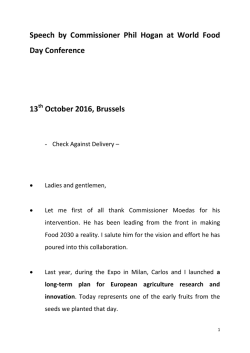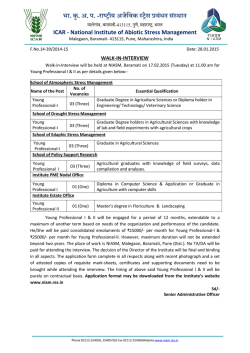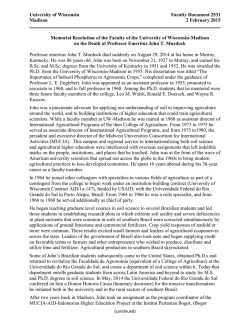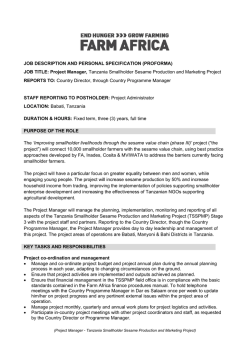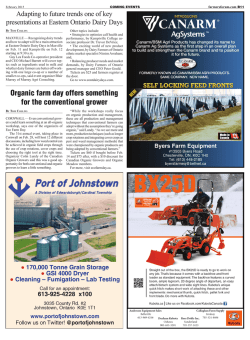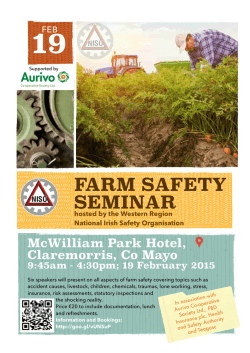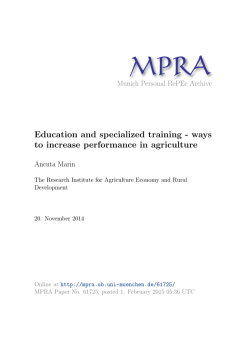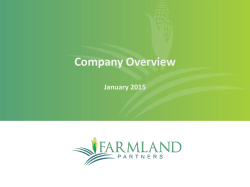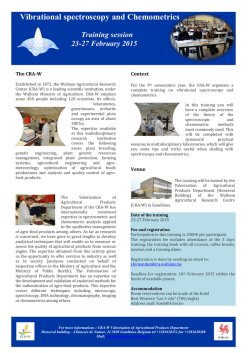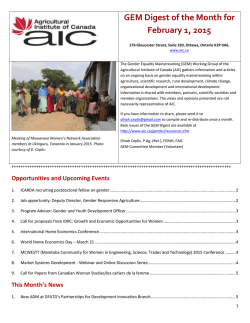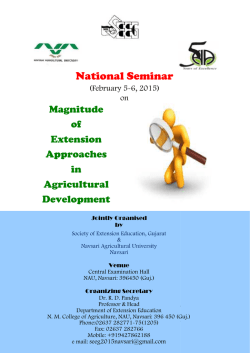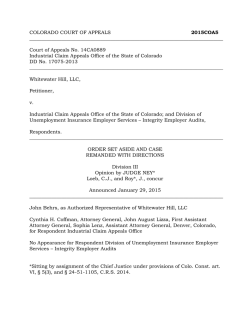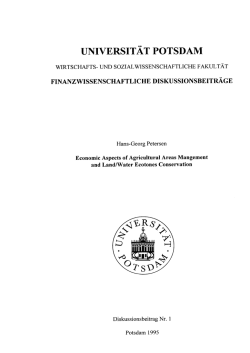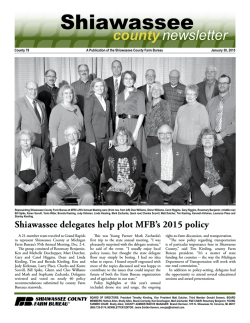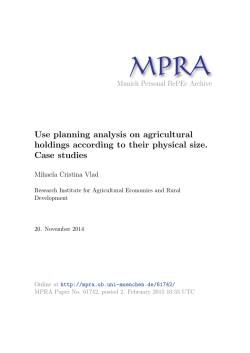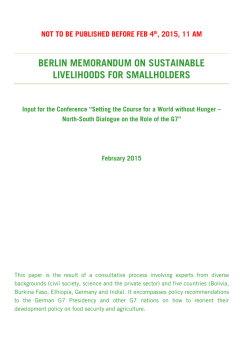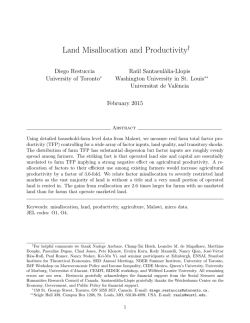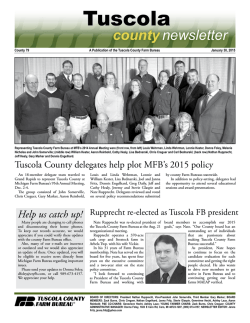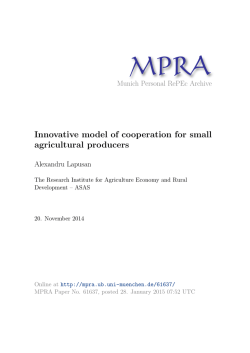
Policy Perspectives from the 2014 Farm Journal Forum
Globally Positioned Agriculture Policy Perspectives from the 2014 Farm Journal Forum At the 16th Farm Journal Forum, we asked speakers, panelists and attendees to share their policy recommendations on some of the key challenges facing agriculture and food security. Below is a list of questions posed to the Forum audience and a compilation of their responses. 1. What provisions are missing from the 2014 farm bill? 2. How do we build coalitions of support for agriculture in the policy debate? Who else should be included? 3. How do we engage millennials in farming and the agricultural workforce? 4. How can the U.S. agricultural community contribute in different ways to global food security? 5. What are your recommendations for 2015 and beyond? Policy Ideas Generated from the Forum’s Mini Think-Tank What provisions are missing from the 2014 farm bill? ■T he bill lacked a meaningful focus on those who need the help and should provide a price-based safety net for farmers who need it most. ■W e need to think about trying to demystify farming and food preparation. Is there anything to be gained from advocating for a return of home economics to our public schools? We should be teaching students about basic food preparation, preserving, gardening and personal finance. ■T he question should read instead—what provisions or restrictive laws should not be in the farm bill? We build policy looking at short-term needs and not long-term needs, i.e. infrastructure and value-added agriculture. We should start from scratch with no federal assistance and then build on that. ■A uthorize Agricultural Land Management Greenhouse Gas (ALM/GHG) offset credits and revenue from farmer participants in CRP and other USDA conservation programs. ■ I mprove food aid efficacy by freeing programs from limitations on Local and Regional Procurement (LRP) and requirement that aid be shipped on U.S.-flagged ships. ■P olicy needs to be more adaptable. Invest in irrigation. How do we build coalitions of support for agriculture in the policy debate? Who else should be included? ■C onsumers, fruit and vegetable, direct-to-consumer growers, Medicaid advocates ■M ayors, governors, college chefs (College Chef Association) ■E ngage more of the industry at the grass roots, but they need to be willing to speak out and tell our story. Put more youth in front of media and on social media telling the story. ■U se the “same language” to identify common goals with other groups. ■ Land managers and eaters. ■C hange how we define “agriculture.” Right now, the definition only covers the 1% to 2% of our population engaged in farming, but it should include the entire value chain. ■C elebrity chefs and foodies. How do we engage millennials in farming and the agricultural workforce? ■R eauthorize the Elementary and Secondary Education Act and the Carl D. Perkins Career and Technical Education Act to include more support for consumer sciences, STEM education including agriculture, and digital fluency. ■T ransparency—they want to know more about what they eat, how it is produced, where it is produced, etc. ■M ore great videos by the Peterson Brothers. ■M ake agriculture “sexy” again The Green Data revolution will help l Ability to illustrate you can make a profit l Using technology to create/grow a product the world needs l ■T he industry needs to clean up its image about what a farmer is first, then prove it’s a professional career choice. ■R aise income possibilities by maximizing CRP, Payments for Environmental Services (PES), ALM/GHG offset and precision agriculture revenue possibilities or cost-savings for the farmer. ■P ush to have agriculture included in the definition of “STEM education.” ■W e need to showcase technology that is used in agriculture and farming more. It would get them to see farming in a whole new light. How can the U.S. agricultural community contribute in different ways to global food security? ■M ore farmer-to-farmer exchanges—provide technology. ■P artner with farmers in other parts of the world—listen to and learn from each other. ■G etting involved in U.S. policy discussion with outreach to policy leaders. Without guiding our Congressional leaders, we risk the inability to feed a growing world. ■ I nsist that USAID and the World Bank require that poor-country farmers be empowered legally to enjoy the same land tenure security that U.S. farmers enjoy ■L everage the U.S. land grant and Extension system, stressing a focus on STEM disciplines and gender equality, as a model for empowering developing countries’ economic growth. What are your recommendations for 2015 and beyond? ■ I ncrease focus on the convergence of organic and traditional biotech agriculture. ■L ink advocates for health and nutrition and need for healthy food. ■L ink food and agriculture policy debate to the fast-growing Latino farming population via Univision and link African American farmers via BET-TV. ■W e need a frank acknowledgement by those who advocate for agriculture and the rural economy of the toxic impact that the culture wars (creationism vs. evolution, gender equity, gay rights, racial issues) is leaving on urban perceptions of rural America. ■W hen talking farm bill, transportation/infrastructure needs, etc., it would be wise to start building out ideas that are not reliant fully on federal funding to build markets, build infrastructure, etc. We can begin to build out/ propose models that have multiple financial partners to include public, private and consumer funding. ■W hat is the structure and growth model of a future institutional farm? Consider whether farm policy will affect farm growth and structure to the benefit of less efficient farm businesses. ■W e should expel countries from the United Nations that do not allow women to own agricultural land. ■M any long-term policy issues that are important to agriculture, such as infrastructure investment, biofuels, and climate change, are not under the jurisdiction of the House and Senate Agriculture Committees, so we must look beyond the farm bill in order to play an effective role in the federal policymaking process. ■D irect more funding toward training skilled workers Other Policy Ideas Aired at the Forum Agricultural Development ■ I nvesting in agriculture is investing in the stability of the world. The land grant system has been responsible for important education and research that underpinned American agriculture. This model could work in other countries supporting smallholder farmers. ■F ollowing up on Secretary Vilsack’s discussion of working with Wall Street to bundle U.S. rural/agricultural infrastructure projects into a new asset class available for investors, why can’t the U.S. develop public/private partnership in this area in the U.S. with direct private sector participation rather than using Wall Street to create intermediaries? Can this approach of creating new asset class of rural/ag infrastructure projects be adapted to encourage additional investment in Africa and other developing regions? Agricultural Trade ■ I f the Doha Round fails to yield a successful multilateral trade agreement, the U.S. should use the TPP as a platform for trade liberalization going forward. Japan’s decision to join the TPP, including the prospect of liberalizing its agricultural sector, was important. The end-game of getting market access for the full spectrum of agricultural products in Japan, with no major exemptions, is the linchpin issue. If TPP can be completed successfully, there are already key players, like India and China, lined up to join the agreement in the second round. Thus, in the first round, where U.S. negotiators have the most leverage, the deal must be as strong as possible. ■T he U.S. government must look at the African Growth Opportunity Act (AGOA) re-authorization in 2015 as a potential mechanism to help African countries improve their agricultural trade flows.
© Copyright 2024
